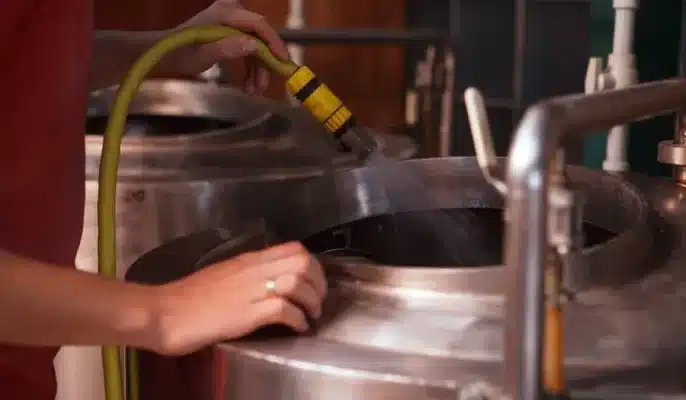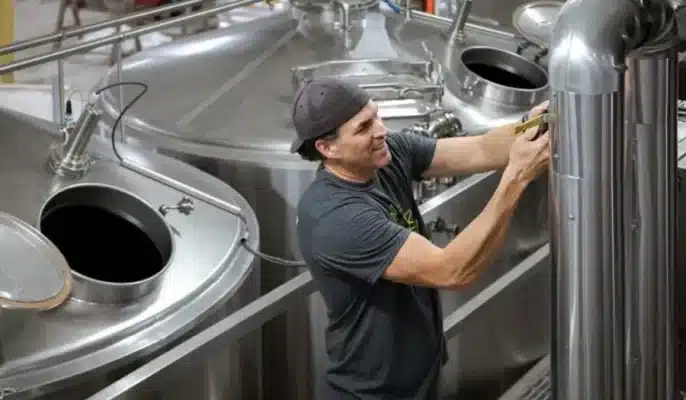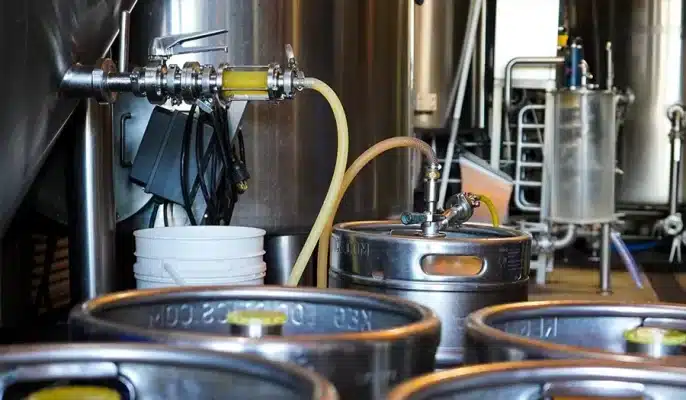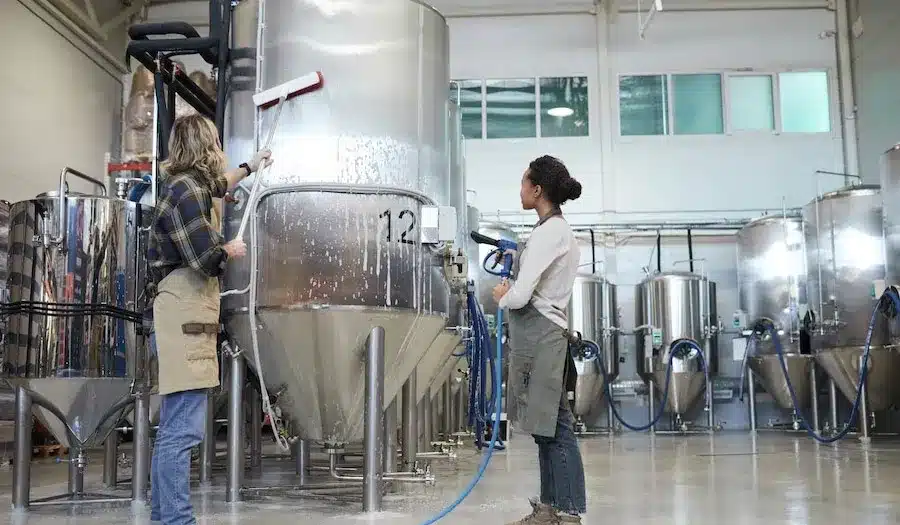Le brassage de la bière est un processus complexe qui fait intervenir divers équipements et matériaux de brassage. Au cours de ce processus, le nettoyage et la désinfection de l'équipement de brassage sont essentiels pour garantir la sécurité et la qualité du produit. L'assainissement est généralement considéré comme l'étape la plus critique du processus de brassage de la bière. Si vous êtes un brasseur novice ou si vous êtes sur le point d'utiliser un kit de brassage domestique pour la première fois, vous vous demandez peut-être comment nettoyer l'équipement du kit de brassage domestique pour obtenir les meilleurs résultats. Cet article explique en détail comment désinfecter efficacement le matériel de brassage, y compris la préparation, la sélection des étapes de nettoyage, les précautions, etc., afin d'aider les brasseurs à produire une bière délicieuse.
Qu'est-ce que la saleté ?
La saleté est un terme général utilisé pour décrire les dépôts organiques et inorganiques. Pour la bière et le vin, la source la plus courante de "saleté" est constituée par les dépôts de protéines et de minéraux. Ils proviennent des grains, des fruits, du houblon et de l'eau et adhèrent facilement aux plastiques. Lorsque des bactéries commencent à se développer, elles forment le tartre, l'écume et le biofilm.
La saleté est rusée. Votre cuve de fermentation peut sembler très propre, mais elle est pleine de micro-organismes et de bactéries invisibles. Il ne faut jamais "supposer" qu'il est propre, c'est la racine du désastre.

Préparation
Mise hors tension et arrêt
Avant tout travail de nettoyage et de désinfection, vous devez vous assurer que l'équipement a cessé de fonctionner et que l'alimentation électrique a été coupée. Cela permet non seulement d'assurer la sécurité de l'opérateur, mais aussi d'éviter que l'équipement ne soit endommagé à la suite d'une erreur de manipulation. Vérifiez soigneusement tout le matériel de brassage, y compris les cuves de fermentation, les bouteilles, les tuyaux, les filtres, etc., afin de vous assurer qu'ils sont intacts et adaptés au nettoyage et à la désinfection.
Éliminer les résidus
Nettoyez les débris et la saleté à la surface de l'équipement, y compris les réservoirs, les tuyaux, les vannes, les pompes, etc. Ces résidus peuvent interférer avec l'effet du nettoyage et de la désinfection, et même affecter la qualité des produits de brassage ultérieurs.
Préparer les outils et les désinfectants.
Préparez les outils de nettoyage et les désinfectants nécessaires en fonction du type et de l'échelle de l'équipement. Les outils de nettoyage les plus courants sont les brosses, les éponges, les pulvérisateurs, les pistolets à eau à haute pression, etc. La sélection des désinfectants doit respecter les principes de qualité alimentaire, d'efficacité et de sécurité, tels que le peroxyde d'hydrogène, la poudre de blanchiment, les désinfectants acides ou les désinfectants spéciaux de qualité alimentaire.
Choix d'un désinfectant
- L'eau de Javel : Le chlore est le principal ingrédient et peut tuer efficacement la plupart des bactéries et des virus. La concentration recommandée se situe généralement entre 200 et 1 000 ppm. Soyez prudent lorsque vous l'utilisez, car l'eau de Javel est très irritante.
- Acide acétique : Désinfectant naturel convenant à certains besoins de désinfection plus légers. Son environnement acide peut inhiber la croissance bactérienne, mais sa capacité à tuer est relativement faible.
- Désinfectant commercial : de nombreux produits désinfectants destinés à la brasserie ont généralement un effet désinfectant important et sont relativement sûrs pour les ingrédients de brasserie. Lors du choix, il convient de vérifier le mode d'emploi du produit pour s'assurer qu'il est conforme aux normes de sécurité alimentaire.
- Hydroxyde de sodium : Désinfectant alcalin puissant qui permet d'éliminer les graisses et certaines saletés tenaces, mais qui doit être utilisé avec précaution pour éviter d'endommager l'équipement.
Les étapes du nettoyage
- Nettoyage préliminaire : Démontez le matériel de brassage et nettoyez chaque pièce l'une après l'autre. Utilisez de l'eau chaude et un détergent approprié pour éliminer les salissures superficielles.
- Utilisez une brosse pour nettoyer les zones difficiles d'accès afin de vous assurer qu'il n'y a pas de résidus. Rincez abondamment à l'eau claire après le nettoyage.
- Préparation du désinfectant : Préparez le désinfectant avec précision en suivant les instructions du désinfectant choisi. Veillez à la propreté des ustensiles pour éviter toute contamination croisée.
- Lors de la préparation du désinfectant, portez des gants et des lunettes de protection pour garantir la sécurité.
- Traitement de désinfection : Vaporisez ou imbibez uniformément le désinfectant préparé sur l'équipement. Pour les grandes surfaces, l'utilisation d'un flacon pulvérisateur permet d'obtenir une couverture plus homogène. Veillez à ce que chaque surface soit couverte de désinfectant. Si nécessaire, utilisez une brosse pour essuyer doucement afin de vous assurer que le désinfectant pénètre dans tous les coins. Le temps de désinfection dépend du type de désinfectant, généralement de 10 à 30 minutes.
- Rinçage minutieux : Une fois la désinfection terminée, rincez soigneusement l'équipement à l'eau claire pour vous assurer que les résidus du désinfectant sont éliminés afin d'éviter d'affecter le produit brassé. Il convient d'accorder une attention particulière au rinçage de l'eau de Javel afin d'éviter qu'elle n'ait des effets néfastes sur la substance brassicole.
- Séchage : Placez l'équipement nettoyé dans un environnement bien ventilé pour qu'il sèche naturellement. Un environnement humide favorise la croissance bactérienne. Un séchage complet est donc une étape importante pour garantir l'efficacité de la désinfection.

Que se passe-t-il si vous ne nettoyez pas votre équipement de brassage de bière?
- Croissance bactérienne : Les matières organiques résiduelles et les sucres constituent un milieu propice à la prolifération des bactéries, ce qui entraîne des fermentations anormales, voire des odeurs et des matières étrangères.
- Défauts de goût : Les contaminants peuvent modifier la saveur de la bière et produire des odeurs désagréables telles que l'aigreur et la corruption.
- Échec de la fermentation : Un équipement mal nettoyé peut entraîner une perte d'activité de la levure, affecter les résultats de la fermentation et entraîner une diminution de la production.
- Risques pour la sécurité des produits : La contamination bactérienne peut entraîner des risques pour la santé, produire des substances nocives et affecter la sécurité des consommateurs.
- Dommages à l'équipement : L'accumulation à long terme de saletés peut corroder l'équipement et réduire sa durée de vie.
Comment garder le matériel de brasserie propre ?
Nettoyage régulier
La première étape pour maintenir la propreté du matériel de brasserie est un nettoyage régulier. Après chaque utilisation, l'équipement doit être nettoyé immédiatement pour éviter que les résidus ne sèchent. Cela permet non seulement d'éliminer les matières organiques et le sucre, mais aussi de prévenir la croissance bactérienne. Il est recommandé d'utiliser de l'eau chaude et un détergent approprié pour s'assurer que chaque pièce est bien nettoyée.
Utiliser des détergents appropriés
Le choix du bon détergent est essentiel pour garantir les résultats du nettoyage. Vous pouvez utiliser des détergents alcalins ou acides spéciaux, qui peuvent éliminer efficacement la saleté et les sédiments. En fonction du matériau de l'équipement, choisissez le bon détergent pour éviter d'endommager l'équipement.
Rinçage complet
Après le nettoyage, veillez à rincer soigneusement l'équipement à l'eau chaude pour vous assurer que tous les détergents et résidus ont été éliminés. Les détergents résiduels peuvent affecter la saveur et la sécurité de la bière, c'est pourquoi le processus de rinçage doit être méticuleux et suffisant. Vous pouvez utiliser un pistolet à eau à haute pression pour faciliter le rinçage et vous assurer que chaque recoin est nettoyé.
Désinfection régulière
Outre le nettoyage, une désinfection régulière est tout aussi importante. Utilisez des désinfectants appropriés, tels que de l'eau de Javel ou des désinfectants spéciaux, pour désinfecter l'équipement entre deux utilisations, en particulier lorsque vous changez de lot ou que vous n'utilisez pas l'équipement pendant une longue période. La désinfection permet de tuer efficacement les bactéries et les micro-organismes potentiels et de garantir la sécurité du brassage.
Vérifier l'équipement
Vérifier régulièrement l'équipement pour s'assurer qu'il n'y a pas d'accumulation de saletés ou de dommages. Il s'agit notamment de vérifier tous les équipements connexes tels que les cuves de fermentation, les tuyaux, les filtres, etc. La détection et la résolution des problèmes en temps utile permettent d'éviter les accidents de production ou la dégradation de la qualité causée par des problèmes d'équipement.
Préserver la propreté de l'environnement
Il est tout aussi important de maintenir l'environnement de brassage propre. Nettoyez la zone de travail pour éviter que la poussière, les débris et d'autres contaminants ne pénètrent dans l'équipement. Utilisez des housses pour couvrir les équipements non utilisés afin de réduire le risque de contamination externe et de garantir l'hygiène de l'environnement de production.
Former le personnel
Veiller à ce que tous les opérateurs comprennent l'importance du nettoyage et de la désinfection et maîtrisent les méthodes d'exploitation correctes. Organiser régulièrement des formations pour sensibiliser les employés au nettoyage et améliorer leurs compétences afin qu'ils puissent mettre en œuvre efficacement les procédures de nettoyage et de désinfection dans les opérations réelles.

Précautions à prendre lors du nettoyage du matériel de brassage de la bière
- Suivez les instructions : Lisez attentivement et suivez les instructions relatives à l'utilisation du produit de nettoyage, y compris la concentration recommandée et le temps d'utilisation, afin de garantir un effet de nettoyage optimal.
- Choisir le bon désinfectant : lors du choix d'un désinfectant, il faut tenir compte de son effet bactéricide, de son innocuité et de la possibilité qu'il corrode l'équipement. Les désinfectants de qualité alimentaire sont préférables car ils ne contaminent pas les produits brassicoles.
- Remplacer régulièrement les désinfectants : Les désinfectants peuvent devenir progressivement inefficaces au cours de leur utilisation. Il est donc nécessaire de les remplacer régulièrement pour garantir l'efficacité de la désinfection.
- Maintenir de bonnes habitudes d'hygiène : En plus d'une désinfection régulière, vous devez également maintenir de bonnes habitudes d'hygiène, comme nettoyer régulièrement la surface de l'équipement, éviter d'introduire des débris et des contaminants dans la zone de brassage, etc.
- Utilisez des mesures de protection : Lorsque vous effectuez des travaux de nettoyage et de désinfection, vous devez porter des équipements de protection appropriés, tels que des gants, des masques et des lunettes, afin de protéger votre sécurité.
- Éviter la contamination croisée : Lorsque vous nettoyez différents équipements, utilisez des outils et des brosses différents afin d'éviter toute contamination croisée et de vous assurer que chaque pièce peut être nettoyée en profondeur.
- Rinçage minutieux : Après le nettoyage, veillez à rincer soigneusement l'équipement avec beaucoup d'eau propre pour vous assurer que tous les résidus de détergent et de saleté sont éliminés afin d'éviter d'altérer la saveur de la bière.
- Inspection et entretien réguliers de l'équipement : Inspecter et entretenir régulièrement l'équipement, par exemple en remplaçant les joints, en lubrifiant les pièces, etc., afin d'assurer le fonctionnement normal et l'hygiène de l'équipement.
- Formation et communication : Veiller à ce que tout le personnel impliqué dans le nettoyage ait reçu une formation, comprenne l'importance du nettoyage et les étapes spécifiques de l'opération, et maintienne une bonne communication et une bonne coopération.




